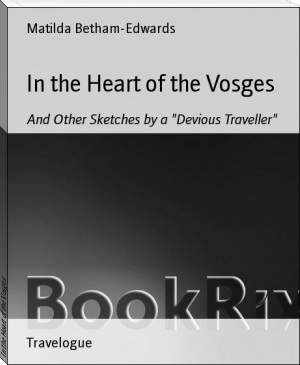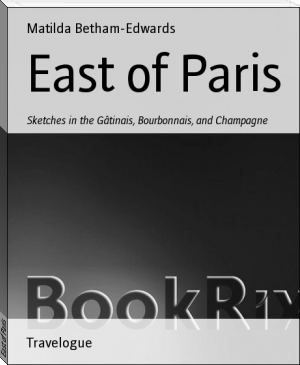In the Heart of the Vosges by Matilda Betham-Edwards (digital e reader TXT) 📖

- Author: Matilda Betham-Edwards
Book online «In the Heart of the Vosges by Matilda Betham-Edwards (digital e reader TXT) 📖». Author Matilda Betham-Edwards
Ploughing and harrowing were being done chiefly by horses, only a few oxen being used. My host told me that his animals were never worked on Sundays. On week-days they remain longer afield than with us, but a halt of an hour or two is made for food and rest at mid-day. Another crop to be mentioned is what is called _hivernage_ or winter fodder, _i.e._ lentils planted between rows of rye, the latter being grown merely to protect the other. On my query as to the school attendance of boys and girls employed in agriculture, my host said that authorities are by no means rigid; at certain seasons of the year, indeed, they are not expected to attend. Among some large landowners we find tolerably conservative notions even in France. Over-education, they say, is unfitting the people for manual labour, putting them out of their place, and so forth.
Moles are not exterminated. "They do more good than harm," said my host, "and I like them." I had heard the same thing at Caumont, where were many mole-hills. Here and there, dove-tailed into these enormous fields, were small patches farmed by the peasants, rarely their own property. Their condition was described as neither that of prosperity nor want. "They get along." That was the verdict.
In our long drive across weedless corn and clover fields we came upon a small wood, a recent plantation of our host. Even this bit of greenery made a pleasant break in the uniform landscape. We then drove home, and inspected the premises on foot. Everything was on a colossal scale, and trim as a Dutch interior. The vast collection of machinery included the latest French, English, Belgian and American inventions. Steam engines are fixtures, the consumption of coal being 160 tons yearly per 300 hectares.
We are thus brought face to face with the agriculture of the future, ancient methods and appliances being supplanted one by one, manual labour reduced to the minimum, the cultivation of the soil become purely mechanical. The idyllic element vanishes from rural life and all savours of Chicago! Stables and neat-houses were the perfection of cleanliness and airiness. Here for the first time I saw sheep stabled like cows and horses. Their quarters were very clean, and littered with fresh straw. They go afield for a portion of the day, but, as I have before mentioned, pastures are few and far between.
The enormous underground store-houses for beetroot, pulp and chopped straw were now almost empty. At midday, the oxen were led home and fell to their strange food with appetite, its moistness being undoubtedly an advantage in dry weather. The cart horses were being fed with boiled barley, and looked in first-rate condition. Indeed, all the animals seemed as happy and well-cared for as my host's scores upon scores of pet birds. Birds, however, are capricious, and nothing would induce a beautiful green parrot to cry, "Vive la France" in my presence. After an animated breakfast--thoroughly French breakfast, the best of everything cooked and served in the best possible manner--we took leave, and my young friend drove me back to Vitry to call upon his own family.
M.D., senior, is a miller, and the family dwelling, which adjoins his huge water-mill, is very prettily situated on the Scarpe. We entered by a little wooden bridge running outside, a conservatory filled with exotics and ferns lending the place a fairy look. I never saw anything in rural France that more fascinated me than this water-mill with its crystal clear waters and surrounding foliage. M.D. with his three sons quitted their occupation as we drove up. Madame and her young daughter joined us in the cool salon, and we chatted pleasantly for a quarter of an hour.
I was much struck with the head of the family, an elderly man with blue eyes, fine features, and a thoughtful expression. He spoke sadly of the effect of American competition, and admitted that protection could offer but a mere palliative. Hitherto I had found a keenly protectionist bias among French agriculturists. Of England and the English he spoke with much sympathy, although at this time we were as yet far from the Entente Cordiale. "C'est le plus grand peuple au monde" ("It is the greatest nation in the world"), he said.
Nothing could equal the ease and cordiality with which this charming family received me. The miller with his three elder sons had come straight from the mill. Well-educated gentlemen are not ashamed of manual labour in France. How I wished I could have spent days, nay weeks, in the neighbourhood of the water-mill!
XIV
LADY MERCHANTS AND SOCIALIST MAYORS
Only three museums in France date prior to the Revolution, those of Rheims, founded in 1748, and of Dijon and Nancy, founded in 1787. The opening in Paris of the Museum Francais in 1792, consisting of the royal collections and art treasures of suppressed convents, was the beginning of a great movement in this direction. At Lille the municipal authorities first got together a few pictures in the convent of the Recollets, and Watteau the painter was deputed to draw up a catalogue. On the 12th May, 1795, the collection consisted of 583 pictures and 58 engravings. On the 1st September, 1801, the consuls decreed the formation of departmental museums and distribution of public art treasures. It was not, however, till 1848 that the municipal council of Lille set to work in earnest upon the enrichment of the museum, now one of the finest in provincial cities. The present superb building was erected entirely at the expense of the municipality, and was only opened two years ago. It has recently been enriched by art treasures worth a million of francs, the gift of a rich citizen and his wife, tapestries, _faience_, furniture, enamels, ivories, illuminated MSS., rare bindings, engraved gems. Before that time the unrivalled collection of drawings by old masters had lent the Lille museum a value especially its own.
The collections are open every day, Sundays included. Being entirely built of stone, there is little risk of fire. Thieves are guarded against by two caretakers inside the building at night and two patrols outside. It is an enormous structure, and arranged with much taste.
The old wall still encircles the inner town, and very pretty is the contrast of grey stone and fresh spring foliage; lilacs in full bloom, also the almond, cherry, pear tree, and many others.
Lille nowadays recalls quite other thoughts than those suggested by Tristram Shandy. It may be described as a town within towns, the manufacturing centres around having gradually developed into large rival municipalities. Among these are Tourcoing, Croix, and Roubaix, now more than half as large as Lille itself. I stayed a week at Lille, and had I remained there a year, in one respect should have come away no whit the wiser. The manufactories, one and all, are inaccessible as the interior of a Carmelite convent. Queen Victoria could get inside the monastery of the Grande Chartreuse, but I question whether Her Majesty would have been permitted to see over a manufactory of thread gloves at Lille!
Such jealousy has doubtless its reason. Most likely trade secrets have been filched by foreign rivals under the guise of the ordinary tourist. Be this as it may, the confection of a tablecloth or piece of beige is kept as profoundly secret as that of the famous pepper tarts of Prince Bedreddin or the life-sustaining cordial of celebrated fasters.
In the hope of winning over a feminine mind, I drove with a friend to one of the largest factories at Croix, the property of a lady.
Here, as at Mulhouse, mill-owners live in the midst of their works. They do not leave business cares behind them, after English fashion, dwelling as far away as possible from factory chimneys. The premises of Mme. C. are on a magnificent scale; all in red brick, fresh as if erected yesterday, the mistress's house--a vast mansion--being a little removed from these and surrounded by elegantly-arranged grounds. A good deal of bowing and scraping had to be got through before we were even admitted to the portress's lodge, as much more ceremonial before the portress could be induced to convey our errand to one of the numerous clerks in a counting-house close by. At length, and after many dubious shakes of the head and murmurs of surprise at our audacity, the card was transmitted to the mansion.
A polite summons to the great lady's presence raised our hopes. There seemed at least some faint hope of success. Traversing the gravelled path, as we did so catching sight of madame's coach-house and half-dozen carriages, landau, brougham, brake, and how many more! we reached the front door. Here the clerk left us, and a footman in livery, with no little ceremony, ushered us into the first of a suite of reception rooms, all fitted up in the modern style, and having abundance of ferns and exotics.
At the end of the last salon a fashionably dressed lady, typically French in feature, manners and deportment, sat talking to two gentlemen. She very graciously advanced to meet us, held out a small white hand covered with rings, and with the sweetest smile heard my modestly reiterated request to be allowed a glimpse of the factory. Would that I could convey the gesture, expression of face and tone of voice with which she replied, in the fewest possible words!
After that inimitable, unforgettable "Jamais, jamais, jamais!" there was nothing to do but make our bow and retire, discomfiture being amply atoned by the little scene just described.
We next drove straight through Lille to the vast park or Bois, as it is called, not many years since acquired by the town as a pleasure-ground. Very wisely, the pretty, irregular stretch of glade, dell and wood has been left as it was, only a few paths, seats and plantations being added. No manufacturing town in France is better off in this respect. Wide, handsome boulevards lead to the Bois and pretty botanical garden, many private mansions having beautiful grounds, but walled in completely as those of cloistered convents. The fresh spring greenery and multitude of flowering trees and shrubs make suburban Lille look its best; outside the town every cottage has a bit of ground and a tree or two.
During this second week of April the weather suddenly changed. Rain fell, and a keen east wind rendered fires and winter garments once more indispensable. On one of these cold, windy days I went with Lille friends to Roubaix, as cold and windy a town, I





Comments (0)